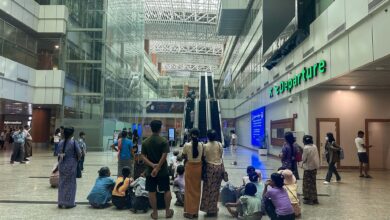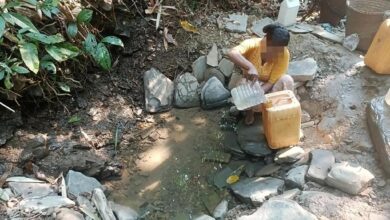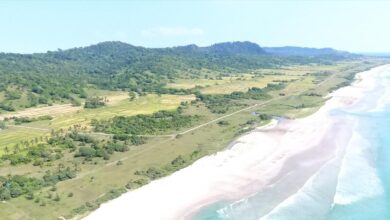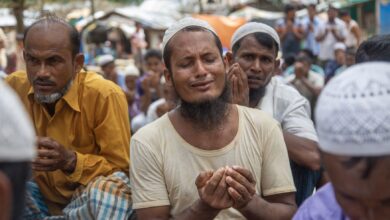
U Maung had hoped to be vaccinated before Thingyan, the traditional Myanmar New Year’s festival in mid-April.
A month later, however, the 69-year-old resident of Myingyan in Mandalay Region still hasn’t received the Covid-19 vaccine that the government started making available in late January.
The reason is that Myanmar no longer has a government. Instead, it is ruled by a dictatorship that has dedicated most of its energy since seizing power on February 1 to crushing anti-coup protests.
The vaccine rollout hasn’t ground to a complete halt, but it has been thrown into disarray, leaving millions exposed to the impact of a power struggle that pits the military against the majority of the country’s population.
For his part, U Maung has decided to take his chances with a virus that has killed millions of people globally over the past year, rather than submit to the ministrations of a regime that has murdered hundreds of civilians in the past three months.
“I have no desire whatsoever to get vaccinated if they’re the ones administering it. I don’t trust them at all,” he said, echoing a sentiment expressed by many around the country.

Fighting on two fronts
A nationwide vaccination program was just getting underway when the junta upended it by overthrowing the elected National League for Democracy (NLD) government.
The NLD program, which aimed to cut the infection rate in a country that ranked fourth in Southeast Asia for the number of confirmed cases per capita, relied on the India-produced Covishield vaccine to protect the most vulnerable.
Starting with 1.5 million doses gifted by India, the NLD government had also ordered another 30 million doses as part of an ambitious program to control the spread of the virus.
Among the first to receive the vaccine were healthcare workers, public servants, and members of parliament. Vaccinations for the general public were due to begin by the first week of February.
But before that could happen, the NLD government was ousted, and the nation faced a new crisis in the form of a return to military rule.
After nearly a year on the frontlines of the battle against Covid-19, healthcare workers soon found themselves at the forefront of a very different struggle. Within days of the coup, medical professionals launched the Civil Disobedience Movement (CDM) against the newly formed junta.
To counter the regime’s efforts to consolidate its control over the state, they abandoned their jobs at public hospitals and began offering their services through charity and private clinics.

They were later joined by tens of thousands of other civil servants. According to the website CDM2021.org, there are over 200,000 public employees taking part in the CDM, of whom more than 17,000 are healthcare workers.
But the loss of much of its medical workforce didn’t prevent the regime from resuming the vaccination program, which has become a key part of its bid to bolster its claims to legitimacy.
However, its efforts to date have done little to inspire confidence. Observers have noted that propaganda images of people being vaccinated betray a slipshod approach that suggests a lack of proper training.
“From the way they hold two or three needles at a time, instead of taking them out one by one, to the way they have the same person both filling the syringes and giving the shot, there are just so many things wrong with how they’re handling this,” said Khine Khine, a nurse from Mandalay.
Specially trained to take part in the mass vaccination program, Khine Khine was forced to choose between fighting the virus and resisting the regime. In February she left her job because she decided the junta represented the greater threat.

A politicized pandemic response
More than three months after the coup, Myanmar has fallen dangerously far behind in its efforts to combat Covid-19.
Instead of receiving 30 million doses of the Covishield vaccine, it has acquired just 3.5 million. Meanwhile, according to the junta’s own figures, as of April 21, just 1.54 million people had received their first shot, while only 340,000 had returned for their second dose after the prescribed four-week interval.
Most of those who are at least partly inoculated belong to the first cohort vaccinated in January. Ironically, that means that CDM workers and MPs in detention or on the run are among the tiny handful of people in the country with some degree of protection from Covid-19.
But it is this same group that is now among the least likely to become fully vaccinated. The vaccination program has become so highly politicized since the coup that rejecting it is seen by many as a way of defying the regime—which has, in turn, weaponized it against its opponents.
Dr Thiha Kyaw, a doctor from Yangon who has joined the CDM, made no secret of his contempt for the generals who are now running the program.
“It’s just a way to defy and oppose those rebels,” he said of his decision to refuse a second shot. “I don’t want to support what they’re doing. I’m being faithful to my country and my people.”

But while this attitude may seem incompatible with his better judgment as a doctor, it also reflects the fact that the junta has made a point of making access to the vaccine contingent on acceptance of its rule.
In Hpa-an, the capital of Karen State, only public servants who have not joined the CDM are eligible to receive the vaccine, according to a local source who spoke to Myanmar Now.
The source, who is close to healthcare workers and teachers participating in the CDM, cited the example of two junior doctors from the city’s general hospital who were vaccinated in January and were later urged to quit the CDM so they could get a second shot. They refused and went into hiding when it became clear that they had come under scrutiny from senior officials.
“The head of the hospital made an announcement that any staff who came back to work would be vaccinated as planned,” the source said, adding that the same offer was made to teachers who abandoned the CDM.

Plagued by distrust
Apart from those deliberately excluded from the vaccination program, there are many others who choose not to participate, either for political reasons or simply out of a lack of trust in the junta’s capacity to implement public-health measures.
Political opposition to the regime reaches far beyond the ranks of CDM workers. Millions have come out around the country to demand the restoration of civilian rule, braving crackdowns that have so far killed more than 800 civilians.
For many, then, the idea of giving the military an opportunity to portray itself as a saver of lives is difficult to stomach. This is why much of the country has shunned its vaccination efforts.

There are also others, however, who take a more pragmatic view.
Maung Shwe, a 58-year-old native of the Kayah State capital Loikaw who has received two shots, said that those who refuse to accept the vaccine from the military are “being extreme”.
Noting that both the general hospital and the military hospital in Loikaw were offering the vaccine at the end of April, he insisted that he really didn’t care where it came from, as long as it worked.
“Whether it’s from the military or the general hospital, you just have to get the vaccine. The military has it and the public hospital has it. They’re both very convenient. We should be grateful,” he said.
This is, of course, exactly what the junta wants to hear. In an article published by state-run media on May 10, the military said it had sent medical teams in response to “the requests of workers and locals in regions facing difficulty.”
It added: “The locals were extremely grateful and satisfied with the healthcare they received.”
The reality, however, is that many remain wary of the regime’s professed commitment to protecting the health of the country’s citizens.
“It is a controversial issue among the public, regarding how much they trust the vaccines” provided by the junta, remarked one observer who has closely followed the vaccine rollout.
One cause of concern is that the regime has started using vaccines sourced from China. In early May, it received a shipment of half a million doses of Vero Cell, a vaccine backed by the Chinese military.
In a country where anti-Chinese sentiment runs strong, this was seen by some as further evidence of Beijing’s self-interested role in perpetuating the Myanmar military’s grip on power.
More generally, however, there is a feeling that the regime can’t be trusted to store and distribute any vaccine properly without the cooperation of trained medical professionals.
“I know the vaccines need to be kept in specific conditions. But most doctors are now involved in the CDM, so I’m concerned the vaccines won’t be handled appropriately,” said Phoe Htoo, a 70-year-old resident of Yinmarbin in Sagaing who said he was unsure about getting the vaccine.

A clear and present danger
Perhaps the most compelling reason that most are lukewarm about receiving the vaccine is the inescapable fact that Myanmar is a nation under siege, where the invisible menace of the coronavirus is eclipsed by the threat of a military run amok.
This fact was underlined on May 6, when regime soldiers shot and killed a woman who had just been vaccinated while she was sitting in a car parked in front of a Mandalay hospital.
By comparison with such atrocities, which have become a regular feature of life under the current regime, Covid-19 seems like a relatively minor concern to many.
“You can protect yourself from infection, and not every case results in death. But with this dictatorship, you’re not even safe in your own home. You’re not safe anywhere. It’s a constant mental torture,” said a 20-year-old man in Tamu, a town in Sagaing Region that has seen major clashes between locals and junta forces.
U Maung, the Myingyan native who refused to get the vaccine despite being in a high-risk age group, expressed the difference even more starkly.
“If the dictatorship falls, the lives of all 50 million people in Myanmar will be better. Covid-19 won’t kill us all,” he said.
Meanwhile, neighbouring India and Thailand, which have both seen surges in the number of new cases, serve as reminders that the pandemic is far from over.
It is difficult to gauge the extent of the spread of the disease in Myanmar because testing has been reduced to just a tenth of what it was before the coup.

More than 60% of the cases diagnosed before February were asymptomatic, so it is likely that the number of new cases reported by the regime—just a dozen or so per day since mid-April, based on an average of about a thousand tests a day—greatly understates the magnitude of the problem.
So far, more than 140,000 have tested positive for Covid-19 since the start of the pandemic, of whom 3,212 have died, according to official figures.
While a more accurate measure of the scale of the disaster may prove elusive, one thing is clear—that most would rather rely on their own vigilance than on the mismanaged efforts of a despised regime to protect them from harm.
“It’s not a problem to not be vaccinated right now, for the country or its people. Just wear your masks and wash your hands often,” said Dr Thiha Kyaw.
Editor’s Note: All names in this story have been changed to protect the identity of sources.



